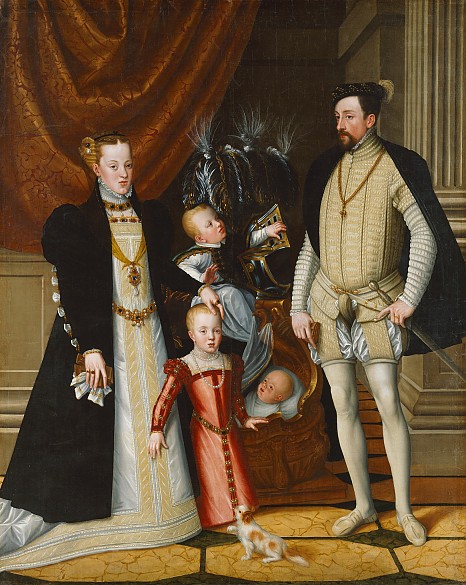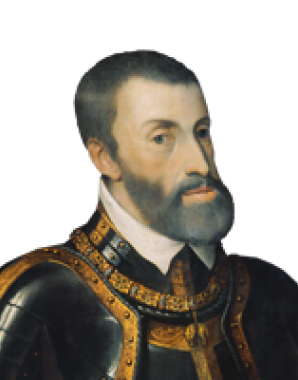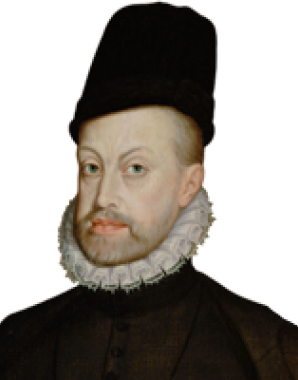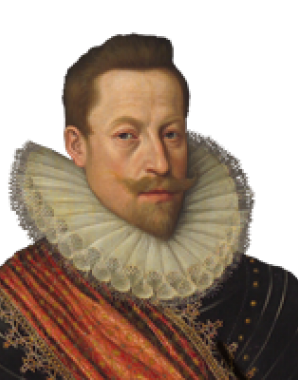Maximilian II: marriage and offspring
The marriage between Maximilian and his first cousin Maria of Spain was the first in a long line of unions that were to take place within the immediate family circle. An almost impenetrable interlacing of ties between the two dynastic lines over generations led to the creation of a genetically homogeneous clan.
Maximilian’s wife was the Spanish infanta Maria (b. 1528), a daughter of Emperor Charles V and Isabella of Portugal. The marriage was concluded in 1548 as the result of pressure from Spain and was intended to emphasize the political and genealogical union between the two lines.
As the representative of interests of her brother, Phillip II, Maria had a highly influential position at the imperial court. With their self-assured, at times arrogant demeanour, her Spanish retinue and in particular her confessors gave rise to friction with the Austrian nobility, which felt it was being sidelined. In 1581, a few years after her husband’s death, she returned to Spain, where she continued to harbour political ambitions. However, these came to nothing. Maria died in her native country at a ripe old age, but isolated, in 1603.
Maximilian and Maria were the founders of the main Austrian line of the dynasty. This marriage between two first cousins produced sixteen children, of whom nine survived infancy. Despite the impressive tally of six sons who reached adulthood this line was to die out in the very next generation due to a lack of legitimate male offspring. Rudolf II and Ernst remained unmarried, while as men of the Church Maximilian III and Wenzel were subject to the rule of chastity, and the marriages of Matthias as well as Albrecht remained childless.
Their first-born daughter Anna (1549–1580) married King Phillip II, her maternal uncle, who had already been widowed three times and was twenty-two years older than his child bride. In ten years of marriage Anna gave birth to four children who all died in infancy except for one, the long-awaited heir to the throne, Phillip III. Anna thus preserved the Spanish line from extinction.
The eldest son Rudolf (b. 1552) succeeded his father on the imperial throne.
Ernst (1553–1600) was brought up together with his elder brother Rudolf in Spain. A deep tie of affection persisted between the two brothers, even during the period of the emperor’s mental infirmity, when the rest of the family involved in the ‘Bruderzwist’ turned away from him. As a confidant of his brother, Ernst was initially appointed governor in the archduchy of Austria, where he promoted the Catholic Counter Reformation. Appointed governor of the Netherlands by King Phillip II in 1593, he fought a losing battle there, unable to prevent the secession of the northern provinces. Nowadays it is for his patronage of the arts rather than his political activities that Archduke Ernst is remembered. He developed a great interest in Flemish painting, which at that time was enjoying a golden age. The great Bruegel holdings of the Kunsthistorisches Museum in Vienna were a result of his collecting activities.
From her earliest childhood Maximilian’s daughter Elisabeth (1554–1592) had been part of her father’s plans for a rapprochement with France. In 1569 she was married to the French king Charles IX, the son of Henry II of France and Catherine de Medici. The marriage was unhappy, and after her husband’s death Elisabeth returned to Austria in 1574. In Vienna, as an act of reparation for the St Bartholomew’s Day massacre of Protestants in Paris in 1572, she endowed a religious foundation named the Queen’s Convent after her, where she spent the rest of her days. The convent was dissolved under Joseph II.
As the rival of his brother Rudolf, Archduke Matthias (b. 1557) was to play an inglorious role in the fraternal conflict within the dynasty, successively assuming his position as ruler.
Maximilian III (1558–1618) was intended to make a career in the Church. At first however, he embarked on a brief adventure as candidate for the Polish throne; however, his attempt to seize power by force of arms ended in a fiasco. Later his hopes of obtaining various episcopal benefices fell through, but the archduke was eventually promised the office of Grand Master of the Teutonic Knights, which he held until his death. Maximilian III was the first in a long line of Habsburg princes to hold this post. He focused the activity of the order on defending the Austrian dominions from Turkish expansionism, giving a new sense of purpose to an institution that had originally been founded to protect pilgrims against Muslims during the Crusades.
Within the dynasty he supported the emancipation of the Austrian line from Spanish tutelage. In the Holy Roman Empire he became a mediator respected by all parties between the hardening fronts. Maximilian died shortly before the outbreak of the Thirty Years’ War, the root causes of which he had vainly tried to remedy.
The next-born son was Albrecht (1559–1621). Brought up in Spain, he spent his life in the service of the Spanish crown. Initially intended for a career in the Church, he became a cardinal and archbishop of Toledo at eighteen. He also held various political offices in the Spanish king’s name, including the vice-regency of Portugal from 1583, and from 1595 the governorship of the Netherlands, where his tenure of office was overshadowed by the northern provinces’ successful struggle for independence. Later he returned to the secular state and married infanta Isabella Clara, the daughter of his uncle, King Phillip II, who made over to him the regency of the Netherlands. This would have meant the emergence of a separate Netherlandish line of the dynasty, but as his marriage remained childless, the Netherlands passed back to the Spanish king after Albrecht’s death in 1621.
Wenzel (1561–1578) was also intended to receive a post in Spain and was designated grand prior of the Knights of St John in Castile. However, he died at the young age of seventeen.
At the tender age of thirteen, Margarete (1567–1633) was intended to follow her elder sister Anna, who had died young, as the fifth wife of King Phillip II of Spain. These plans were never realized, however, and Margarete opted to enter a convent. At the age of sixteen she entered the Order of the Poor Clares, spending the rest of her life as a nun in Spain.
















